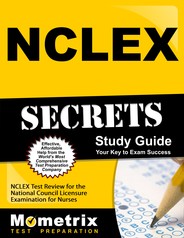One of the primary differences between the NCLEX RN test and NCLEX PN test is the different number of questions. Please review the following chart:
| NCLEX RN Test | NCLEX PN Test | |
| Minimum Number of Questions | 85 | 85 |
| Maximum Number of Questions | 150 | 150 |
Both of these tests require the same basic understanding of nursing practice and knowledge. The NCLEX RN test questions and the NCLEX PN test questions are presented with four multiple choice answer scenarios. In some cases, the NCLEX test is using a more difficult question format that requires multiple right answers to be selected. However, the material that is covered is the same.
Prepare with our NCLEX Study Guide and Practice Questions. Print or eBook. Guaranteed to raise your score. Get started today!
 Get Your Study Guide
Get Your Study Guide
The National Council of State Boards of Nursing (NCSBN) in conjunction with Pearson VUE administers two tests that are used to aid in the determination of the licensure of nurses. These examinations are the National Council Licensure Examination for a Practical Nurse (NCLEX PN) and the National Council Licensure Examination for a Registered Nurse (NCLEX RN). These two tests are used with state and territorial boards of nursing to aid in the determination of the licensure of nurses.
The NCLEX PN test and NCLEX RN test are given on computer using a computerized adaptive testing (CAT) method. This allows candidate ability to be estimated from their responses to questions on the exam, thereby allowing questions that are nearly equal to the candidate’s ability to be asked. This CAT method also aids in the scoring of the examination.
When a candidate has answered enough questions (at least the minimum required) and it is clear that the candidate’s ability is above or below a passing standard, to a 95% certainty, the examination will stop, and the candidate will either pass or fail. There is no correlation between the length of the exam and whether or not a candidate will pass or fail, and in order to pass, a candidate must perform above the passing standard.
In some situations, a candidate may run out of time on the examinations. If this happens, it means that the computer could not determine if the candidate was performing below or above the passing standard to a 95% certainty. In the scoring of exams in this situation, a rule of “last 60” is utilized. If the candidate had been performing above the passing standard for the last 60 questions, the candidate will pass the examination.
During the exam, it is best to keep a steady pace and to spend no more than approximately one minute on each exam question. This will insure that time does not run out, and that all necessary questions are answered.
Affiliate disclosure: As an Amazon Associate, we may earn commissions from qualifying purchases from Amazon.com.




